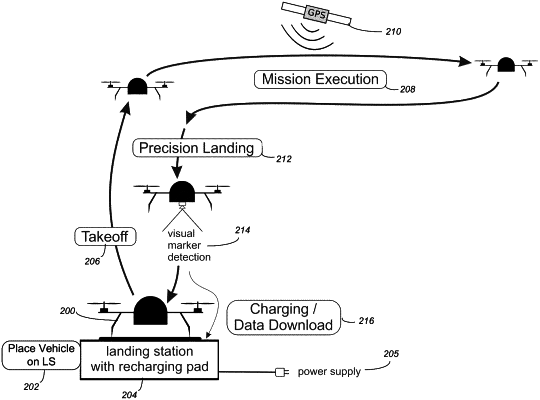| CPC B64F 1/362 (2013.01) [B60L 53/12 (2019.02); B60L 53/14 (2019.02); B64C 39/024 (2013.01); B64D 47/08 (2013.01); B64F 5/60 (2017.01); G05D 1/0088 (2013.01); B60L 2200/10 (2013.01); B64U 10/13 (2023.01); B64U 30/20 (2023.01); B64U 2101/00 (2023.01); B64U 2101/30 (2023.01); B64U 2201/10 (2023.01)] | 30 Claims |

|
1. A method for autonomously operating an unmanned aerial system (UAS), comprising:
(a) the UAS autonomously taking off from a take-off landing-charging station;
(b) the UAS autonomously executing a mission based on a mission plan, wherein:
(1) the executing comprises the UAS autonomously observing data during flight;
(2) the executing comprises the UAS autonomously updating the mission plan based on the observed data; and
(3) the mission comprises a set of waypoints connected by individual trajectory segments, wherein the individual trajectory segments are autonomously generated onboard the UAS;
(c) the UAS autonomously traveling to a hover position above a target landing-charging station;
(d) the UAS autonomously precision landing on the target landing-charging station, wherein the precision landing comprises:
(1) the UAS utilizing a camera to detect a landing bundle comprised of multiple tag fiducials, wherein a placement of the multiple tag fiducials around a charging area of the target landing-charging station will not obscure the charging area;
(2) the UAS performing a landing bundle calibration by:
(A) calibrating the camera and the multiple tag fiducials based on:
a camera frame of the camera;
a master tag of the multiple tag fiducials;
additional tags of the multiple tag fiducials; and
a position and altitude of each additional tag relative to the master tag:
(B) orienting the camera downfacing with the landing bundle visible to form a rigid body transform triad, wherein the rigid body transform triad is comprised of the camera frame, the master tag, and one or more of the additional tags;
(C) collecting a sequence of multiple calibration transforms based on the rigid body transform triad;
(D) combining the multiple calibration transforms to generate a geometric position and an attitude of each of the multiple tag fiducials relative to a landing pad frame;
(3) based on the landing bundle calibration, the UAS utilizing a bundle pose measurement algorithm to produce a bundle pose measurement of the target landing charging-station in a world frame;
(4) utilizing the bundle pose measurement to generate a yaw measurement wherein the bundle pose measurement and yaw measurement are used for landing navigation;
(5) the UAS autonomously realigning itself, using a landing pose estimate, with the target landing-charging station, wherein the realignment is necessary due to drift;
(6) the UAS autonomously determining and issuing a new trajectory to the target landing-charging station; and
(7) the UAS autonomously following the new trajectory to land on the target landing-charging station;
(e) the UAS autonomously re-charging via the target landing-charging station, wherein once re-charged, the UAS is ready to execute a next sortie; and
(f) when landed, the UAS autonomously transmitting mission data,
wherein the UAS autonomously performs the above steps onboard the UAS without any human intervention.
|